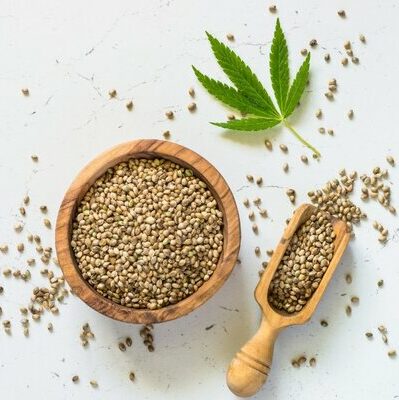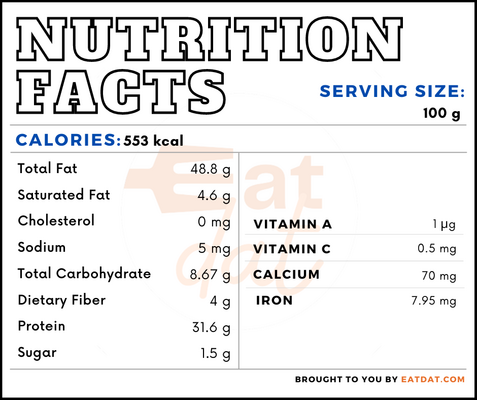
Hemp Seeds
What are Hemp Seeds?
Hemp seeds come from the Cannabis sativa L. plant and were initially a byproduct of the hemp fiber industry. Hemp seeds do not have mind-altering effects and are safe to consume. The seeds are the main edible portion of the plant, though the leaves are also used in making herbal tea or infusions and for adding flavor.
- The seeds are brownish-white in color and have a pleasant nutty taste.
- Though an uncommon ingredient, hemp seeds may be added as topping to salads, yogurt, and smoothies, as well as cooked into sauces and vegetables or made into hemp milk and oil.
Some popular brands of hemp seeds are:
- Manitoba Harvest
- FGO
- Terrasoul Superfoods
- Planet Superfood
- MOCU
- Nutiva
- Navitas Organics
- Healthworks Superfood
- Kirkland Signature
- Earth Circle Organics
- Sunfood Superfoods
Origin of hemp seeds
There is archaeological evidence that hemp was in use 10,000 years ago. Hemp has been used for a variety of things over the years. Ancient Chinese and Ancient Indians were known to consume hemp seeds for their nutritional value. In India, various parts of the hemp plant has been used as medicine. Hemp was a cash crop around the world and was produced in order to get raw materials for various purposes. Today, hemp seeds have resurged in popularity due to their nutritional benefits.
Nutrition
Nutritional profile for hemp seeds (100 gms):

Hemp seeds are rich in magnesium, potassium, phosphorous, folate, and essential fatty acids. Also, they contain calcium, iron, zinc, manganese, niacin, carotene, and vitamin A (IU) in decent quantities.
Hemp provides omega-6 and omega-3 essential fatty acids. Additionally, it contains all the essential amino acids, making it a great plant protein alternative. The arginine found in hemp can also reduce C-reactive Protein (CRP) in the blood, which reduces the risk of heart diseases. Regular consumption of hemp seeds may also reduce the risk of hypertension, atherosclerosis, and inflammation of the glands. Other advantages may include increasing lifespan, improving cognitive function, and preventing obesity, diabetes, and certain types of cancers.
Commercial production
China is the main producer of hemp, growing nearly 70 percent of the world’s production. Other main producers are Canada, the USA, France, Chile, and North Korea. Hemp cultivation requires a temperate and warm climate, as well as well-drained soil with a pH between 6 and 7. The seeds are harvested when they begin to shatter.
Hemp seed recipes
Hemp seeds are traditionally used in certain cuisines to prepare sauces and chutneys. Also, they may be used as topping for a variety of dishes. Here are a few recipes.
- Cookies
- Hemp Seed Butter
- Laddoo
- Hummus
- Baked Cauliflower with Tofu Dressing
- Tabbouleh Salad
- Flax & Hemp Paratha
- Bhang ki Chutney
- Parsley Pesto
FDA regulations
The US government prohibits the production of industrial hemp in the country but has regulations for the import and marketing of by-products of the plant, such as hemp milk, hemp oil, hemp seeds, and hemp flour. However, the 2018 Farm Bill directed the USDA to establish a regulatory framework for hemp production in the USA.
Hemp falls under the category of products containing tetrahydrocannabinols under the FDA. Exemptions for made for the selling of products made from stalks, seeds, and other parts of the plant that are excluded from the definition of marijuana and intended for human consumption.
References
Rodriguez-Leyva, Delfin, and Grant N Pierce. “The cardiac and haemostatic effects of dietary hempseed.” Nutrition & metabolism vol. 7 32. 21 Apr. 2010, doi:10.1186/1743-7075-7-32, https://www.ncbi.nlm.nih.gov/pmc/articles/PMC2868018
Farinon, Barbara et al. “The seed of industrial hemp (Cannabis sativa L.): Nutritional Quality and Potential Functionality for Human Health and Nutrition.” Nutrients vol. 12,7 1935. 29 Jun. 2020, doi:10.3390/nu12071935, https://www.ncbi.nlm.nih.gov/pmc/articles/PMC7400098/
Jayson K. Harper; Alyssa Collins; Lynn Kime; Gregory W. Roth; Heather E. Manzo, Industrial Hemp Production, Penn State Extension, https://extension.psu.edu/industrial-hemp-production
